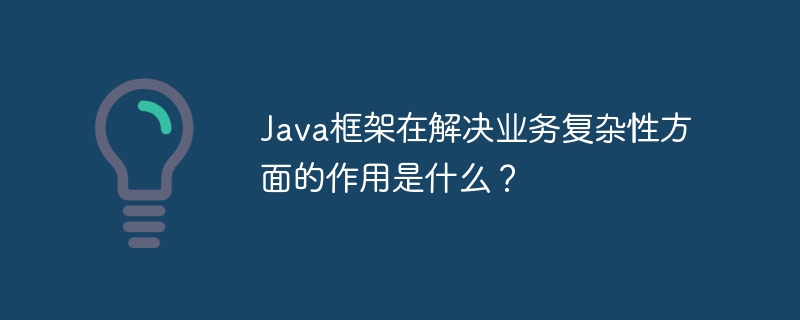The latest trends in Java frameworks in project development: Microservice architecture: Improve application flexibility, maintainability and scalability. Serverless computing: Simplify the development process and focus on writing code. Reactive programming: Handle asynchronous operations to create scalable, high-performance applications. Cloud-native development: Make full use of the advantages of cloud platforms to reduce development complexity.

The latest trends and prospects of Java framework in project development
With the continuous development of technology, Java framework in project development play an increasingly important role. They provide a wide range of features and tools that enable developers to build powerful and efficient applications. This article will explore the latest trends and prospects of Java frameworks and provide some practical cases to illustrate their application.
Trend 1: Microservice Architecture
Microservice architecture is a pattern that decomposes an application into independent services. These services can be independently deployed, updated, and extended, which increases application flexibility, maintainability, and scalability. Frameworks such as Spring Boot and Quarkus support microservices development, allowing developers to easily create and manage microservices.
Practical case: The e-commerce website uses a microservice architecture to decompose functions such as user management, product catalog and order processing into independent services. This allows teams to develop and deploy features in parallel without blocking each other.
Trend 2: Serverless Computing
Serverless computing is a cloud computing model that allows developers to run code without having to manage servers or infrastructure . Frameworks like AWS Lambda and Azure Functions enable serverless development, allowing developers to focus on writing code rather than worrying about infrastructure management.
Practical case: Event processing application uses serverless computing to trigger code execution when a specific event occurs. This allows developers to easily create applications that respond to real-time events, such as sensor data processing or customer notifications.
Trend 3: Reactive programming
Reactive programming is a way of handling asynchronous operations. It allows developers to create applications that react when events occur, even if those events occur on different threads. Frameworks like RxJava and Akka enable reactive programming, allowing developers to write scalable and performant asynchronous applications.
Practical case: Chat application uses reactive programming to process messages in real time. When a user receives a message, the framework triggers code execution, allowing the application to immediately display the message to the user.
Trend 4: Cloud-native development
Cloud-native development is a way of designing applications and services so that they take full advantage of the cloud platform. It includes microservices, serverless computing and containerization technologies. Frameworks like Kubernetes and Docker enable cloud-native development, allowing developers to build applications that can be deployed and managed to run in cloud environments.
Practical case: The online game application is developed using cloud native, and the game server is deployed on Kubernetes as an independent microservice. This allows developers to automatically scale game servers up or down based on demand, ensuring players always have access to their games.
Looking ahead
Java frameworks are constantly evolving to provide developers with the tools they need to build modern, scalable, and performant applications. Trends such as microservices, serverless computing, reactive programming, and cloud-native development are shaping the future of Java frameworks, bringing new possibilities and best practices to developers.
The above is the detailed content of The latest trends and prospects of java framework in project development. For more information, please follow other related articles on the PHP Chinese website!
 负载均衡策略在Java框架性能优化中的运用May 31, 2024 pm 08:02 PM
负载均衡策略在Java框架性能优化中的运用May 31, 2024 pm 08:02 PM负载均衡策略在Java框架中至关重要,用于高效分布请求。根据并发情况,不同的策略具有不同的性能表现:轮询法:低并发下性能稳定。加权轮询法:低并发下与轮询法性能相似。最少连接数法:高并发下性能最佳。随机法:简单但性能较差。一致性哈希法:平衡服务器负载。结合实战案例,本文说明了如何根据性能数据选择合适的策略,以显著提升应用性能。
 Java框架的扩展性和维护成本如何对比?May 31, 2024 am 09:25 AM
Java框架的扩展性和维护成本如何对比?May 31, 2024 am 09:25 AM在选择Java框架时,SpringFramework以其高扩展性见长,但随复杂度提升,维护成本也随之增加。相反,Dropwizard维护成本通常较低,但扩展能力较弱。开发者应根据特定需求评估框架。
 Java大数据处理框架有哪些以及各自的优缺点?Apr 19, 2024 pm 03:48 PM
Java大数据处理框架有哪些以及各自的优缺点?Apr 19, 2024 pm 03:48 PM对于大数据处理,Java框架包括ApacheHadoop、Spark、Flink、Storm和HBase。Hadoop适用于批处理,但实时性较差;Spark性能高,适合迭代处理;Flink实时处理流式数据;Storm流式处理容错性好,但难以处理状态;HBase是NoSQL数据库,适用于随机读写。具体选择取决于数据需求和应用程序特性。
 java框架如何实现松耦合设计?May 31, 2024 pm 05:57 PM
java框架如何实现松耦合设计?May 31, 2024 pm 05:57 PMJava框架通过采用接口与实现、依赖注入、事件驱动架构和服务定位器模式来实现松耦合设计。这些机制允许组件独立于其实现和直接引用而交互,从而提高了可维护性和可伸缩性。在SpringBootRESTAPI等实战场景中,依赖注入和接口的结合使控制器能够轻松使用UserService的任何实现,而无需硬编码依赖性。
 JPA还是MyBatis:选择合适的ORM工具的准则Feb 22, 2024 pm 09:57 PM
JPA还是MyBatis:选择合适的ORM工具的准则Feb 22, 2024 pm 09:57 PMJPA还是MyBatis:选择合适的ORM工具的准则,需要具体代码示例引言:在现代软件开发中,使用ORM(对象关系映射)工具是非常常见的。ORM工具能够将关系型数据库中的表与对象模型间进行映射,大大简化了开发过程。然而,在选择使用哪个ORM工具时,很多开发者常常感到困惑。本文将讨论如何选择适合的ORM工具,重点比较JPA和MyBatis,并给出具体的代码示例
 深入了解Java框架技术栈:探索Spring MVC、Hibernate、MyBatis等常用Java框架Dec 26, 2023 pm 12:50 PM
深入了解Java框架技术栈:探索Spring MVC、Hibernate、MyBatis等常用Java框架Dec 26, 2023 pm 12:50 PMJava框架技术栈:介绍常用的Java框架,如SpringMVC、Hibernate、MyBatis等随着Java的不断发展,越来越多的框架被开发出来以简化开发过程。其中,SpringMVC、Hibernate、MyBatis等是Java开发中最常用的框架之一。本文将介绍这些框架的基本概念和使用方法,帮助读者更好地理解和应用这些框架。第一,我们来介绍Sp
 Java框架和Scala框架在机器学习领域的应用May 31, 2024 pm 12:43 PM
Java框架和Scala框架在机器学习领域的应用May 31, 2024 pm 12:43 PMJava和Scala语言在机器学习中广泛使用。本文介绍了以下Java和Scala框架:Java:Weka(提供机器学习算法和工具)、H2O(分布式内存内机器学习平台)Scala:SparkMLlib(分布式计算库的一部分,提供机器学习算法)、MLpipe(端到端管道库)这些框架可简化机器学习模型构建、提高训练效率、实现可扩展性和生产部署。选择合适的框架取决于项目需求和应用程序的规模和复杂性。
 Java框架在解决业务复杂性方面的作用是什么?Jun 01, 2024 pm 12:09 PM
Java框架在解决业务复杂性方面的作用是什么?Jun 01, 2024 pm 12:09 PMJava框架通过提供组件和设计模式来简化复杂应用程序的开发。MVC架构将应用程序逻辑分为模型、视图和控制器,提高了可维护性和可扩展性。Spring框架是一个流行的Java框架,它提供了完整的MVC框架,用于配置、依赖注入和事务管理。实际应用中,SpringMVC简化了视图、控制器和模型之间的连接,处理请求转发和数据绑定。Java框架简化了应用程序的复杂性,使开发人员能够专注于业务逻辑,创建健壮且可维护的应用程序。


Hot AI Tools

Undresser.AI Undress
AI-powered app for creating realistic nude photos

AI Clothes Remover
Online AI tool for removing clothes from photos.

Undress AI Tool
Undress images for free

Clothoff.io
AI clothes remover

AI Hentai Generator
Generate AI Hentai for free.

Hot Article

Hot Tools

Dreamweaver CS6
Visual web development tools

DVWA
Damn Vulnerable Web App (DVWA) is a PHP/MySQL web application that is very vulnerable. Its main goals are to be an aid for security professionals to test their skills and tools in a legal environment, to help web developers better understand the process of securing web applications, and to help teachers/students teach/learn in a classroom environment Web application security. The goal of DVWA is to practice some of the most common web vulnerabilities through a simple and straightforward interface, with varying degrees of difficulty. Please note that this software

WebStorm Mac version
Useful JavaScript development tools

Atom editor mac version download
The most popular open source editor

MinGW - Minimalist GNU for Windows
This project is in the process of being migrated to osdn.net/projects/mingw, you can continue to follow us there. MinGW: A native Windows port of the GNU Compiler Collection (GCC), freely distributable import libraries and header files for building native Windows applications; includes extensions to the MSVC runtime to support C99 functionality. All MinGW software can run on 64-bit Windows platforms.






